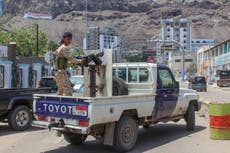The Saudi and UAE cold war in Yemen will only intensify – even with the recent show of unity
Moves by Yemeni separatists in the south have pushed the pair onto the same page, but both Riyadh and Abu Dhabi crave influence in the country

Given its historic support for the group, the UAE’s opposition to the recent declaration of self-rule by Yemen’s Southern Transitional Council (STC) is mind-blowing – though was perhaps inevitable once the UAE decided to bring Aden, Yemen’s temporary capital, under its control.
Despite being part of the Saudi Arabian-led coalition on one side of Yemen’s civil war, the UAE and Riyadh disagree on the future for the STC – with the Saudi’s clear about backing President Abdrabuh Mansour Hadi’s UN-recognised government.
The separatist group declared control over the key port city of Aden and other southern provinces while its leaders were in Abu Dhabi, and were instantly met with fierce opposition by many other southern provinces as well as the UAE and Saudi Arabia.
This unilateral move is not the first standoff between the Saudi and Emirati surrogates in southern Yemen. There is much bad blood between the separatists and Hadi’s government. The STC complains about historical marginalisation by the northerners. They also grumble about the government sidelining them in favour of the Islah party, the sturdy Muslim Brotherhood branch in Yemen.
The government denies these allegations and preaches unity. When confrontations between the government and STC took a bloody turn last August, the UAE sided with the latter, even sending its fighter jets to bombard the very Hadi government it came into Yemen to support against the Iran-backed Houthis. However, this time, Abu Dhabi refused to intervene.
The question now is: what happened between Riyadh and Abu Dhabi to bring about their seemingly united front against the STC? We will likely never know. Perhaps the UAE realised that pushing the STC’s agenda now would be unwise, as backing self-rule in the south would mean blowing up the “Riyadh Agreement”.
The peace agreement, signed between the government and the separatists late last year, makes Saudi Arabia arbiter of the precarious relationship between the two sides, with the agreement reiterating Hadi’s authority but calling for the forming a unity government.
However, cracks in the Saudi-Emirati marriage of convenience in south Yemen meant the Riyadh agreement had little chance to be fully implemented on the ground. An Arab diplomat described the struggle of wills in the south as a sign that “the spark has died” between Saudi Arabia and the UAE over Yemen.
But did the spark ever really exist? Both Saudi Arabia and the UAE joined forces against the Houthis to stop Yemen – the poorest country in the region – becoming a new Iranian front. They have failed. Now the two sides’ proxies have seemingly turned against each other to protect their respective masters’ interests.
The UAE has always been keen on controlling the waterways south of Aden, including the strategic Port of Hudaydah and the Bab al-Mandab Strait, to push back against the increasing Iranian influence over maritime routes. It also wants to protect shipments of oil and other goods, especially from the Port of Jebel Ali in Dubai. By dominating the most crucial sea corridors for oil exports, the UAE also sought to attach itself to Saudi Arabia at the hip.
“From the UAE viewpoint, this was a long term insurance policy for times when the relationship with Saudi Arabia comes to a halt,” Helen Lackner, the visiting fellow at the European Council on Foreign Relations and expert on Yemen, told me.
However, Saudi Arabia too had its own arrangements. By establishing vast clout in the strategic province of al-Mahra, Riyadh could guarantee the flows of its oil to the Arabian Sea. Al-Mahra is one of the biggest Yemeni provinces. Its strategic location between the Saudi borders and the Gulf of Aden makes it a perfect passageway for a Saudi oil pipeline that could spare Saudi Arabia the perpetual uncertainty and instability around the Strait of Hormuz and the Iranian domination over it.
Controlling Aden, through their proxies, is therefore crucial for both countries.
The STC and Hadi’s have their own aims but beyond that if the UAE does not stop supporting the STC, and Saudi Arabia looks beyond the Islah party, implementing the Riyadh Agreement will remain a delusion.
But a political divorce between Saudi Arabia and the UAE would be dangerous, they have a lot in common as to how the future of Yemen should look. The differences are limited to the strategy and the time to push it forward.
Since the UAE’s withdrawal from Aden last summer, Saudi Arabia, for the first time since 2015, was due to gain the upper hand in the city. The STC’s move was designed to block this handover. But if they are to run a local government, the separatists will likely need support and money from Riyadh. After Sunday’s self-rule announcement, they are unlikely to get it.
Meanwhile the war grinds on, and it is the civilians of Yemen that bear the brunt of the geopolitical games being played by those around it.






Join our commenting forum
Join thought-provoking conversations, follow other Independent readers and see their replies